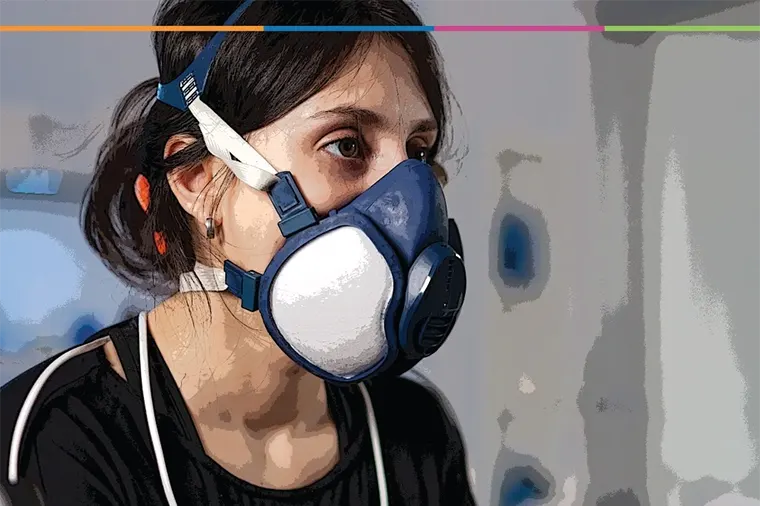Respiratory dysfunction is a common complication following a stroke, but pulmonary rehabilitation can significantly alleviate breathing troubles and reduce the risk of further complications. This type of rehabilitation is essential for preventing issues such as pneumonia, pulmonary ventilation disorders, lung injury, decreased pulmonary compliance, abnormal posture, and obstructive sleep apnea.
Pulmonary rehabilitation for stroke patients encompasses a variety of interventions designed to improve respiratory function and overall health. The main components of this therapy include exercise training, oxygen therapy, non-invasive ventilation, nutrition support, psychological support, and health education.
Role of Respiratory Therapist in Stroke Rehabilitation Center
Respiratory Assessment in Stroke Patients
In patients with chronic neurological disorders, it is important to establish nocturnal symptoms:
- Is the patient’s sleep often disturbed? If so, what causes them to arouse?
- Do they wake up with choking sensations?
- Do they wake up with a headache first thing in the morning?
- Are they tired, especially during the day?
Chest Physiotherapy & Suction Technique
- Pneumonia is a common complication in patients post Stroke.
- The cough reflex is diminished due to weakness of the abdominal muscles, which increases the risk of aspiration.
- Respiratory therapist plays a key role in a post stroke rehabilitation center in performing chest physiotherapy and bronchial hygiene therapy which reduces secretions and lung infections.
- Respiratory therapists perform chest physiotherapy (CPT) to help clear mucus from the lungs. This involves techniques like percussion, vibration, and postural drainage to improve lung function.
- They also perform suctioning to remove secretions from the airways, particularly in patients who are unable to clear their secretions due to conditions like severe respiratory distress, intubation, or a tracheostomy. Suctioning helps prevent aspiration and maintain airway patency.
Oxygen Therapy
- In the stroke rehabilitation center respiratory therapists assess the need for oxygen therapy, determine the appropriate delivery method (e.g., nasal cannula, face mask), and titrate oxygen levels to maintain adequate blood oxygenation.
- They monitor the patient’s oxygen levels using pulse oximetry and arterial blood gases (ABGs), ensuring optimal oxygenation while avoiding oxygen toxicity.
Breathing Exercises
- Breathing Exercises play an important role in improving a patient’s Lung Capacity.
- Inspiratory Muscle Training: Exercises to strengthen the diaphragm and other respiratory muscles.
- Controlled Breathing Techniques: Methods such as diaphragmatic breathing and pursed-lip breathing to improve ventilation efficiency.
Tracheostomy Care
- In stroke rehabilitation center the respiratory therapist makes sure that regular cleaning and care of the tracheostomy site is done to prevent infection.
- Downsizing – It is an invasive procedure for reducing the TT tube size eg- 8.00 mm to 6.00 mm
- Cap closure is a closure of the TT tube from the outside allowing the patient to breathe by nose and to check if the patient has a good cough and Swallow Reflex.
- Decannulation is the removal of the tracheostomy tube once TT cap closures are achieved.
Non-Invasive Ventilation
- Respiratory therapists manage non-invasive ventilation methods like CPAP (Continuous Positive Airway Pressure) and BiPAP (Bilevel Positive Airway Pressure).
- They adjust settings based on the patient’s needs, monitor their response to therapy, and ensure the mask or interface fits properly to minimize leaks and maximize efficacy.
Invasive Ventilation
- They are involved in the management of mechanically ventilated patients, which includes setting up and adjusting ventilators, monitoring ventilator parameters, interpreting blood gases, and making necessary changes to ventilation strategies.
- They also play a key role in weaning patients off mechanical ventilation when appropriate.
In all these areas, respiratory therapists collaborate closely with physicians, nurses, and other healthcare professionals in stroke rehabilitation center to ensure comprehensive care for patients with respiratory disorders.
Also Read This : Rice for Weight Loss: How much Rice should you eat for best results
Disclaimer:
This article provides general information about respiratory therapists and their role in stroke rehabilitation centers, intended for educational purposes only. It is not a substitute for professional medical advice, diagnosis, or treatment. Always consult with your own doctor or a healthcare specialist before making any decisions regarding your health. Well Health Organic does not take responsibility for the accuracy, completeness, or applicability of this information. We do not guarantee the effectiveness of any treatments, products, or information mentioned here, nor do we recommend purchasing any products. The information provided about therapists is solely for knowledge, and we are not responsible for any issues that may arise from the use or interpretation of this information.














